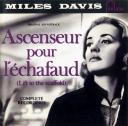Following a fairly successful series on Revisionist Westerns, our second series on Neo-noirs kept running into organizational difficullties and had to be shelved. However, we resume our usual screenings this month, hopefully without further interruptions.
Starting next week, we open with a nod to the Neo-noirs we couldn’t manage to screen. Our first film this year will be Louis Malle‘s 1958 debut venture Elevator to the Gallows, a film that has been a revisionist landmark in ways that transcend its groundbreaking noir improvisations.
Not only the debut directorial feature of Malle, but the film that made Jeanne Moreau a star – in its intensely structured pacing coupled with its generic playfulness, Gallows bridges the austere stylistics of Melville and Bresson with the youthful glory days of the New Wave soon to arrive.
“The new wave doesn’t quite get born in Elevator to the Gallows, but it’s clearly in the late term here, more than ready to emerge. You can sense it in Decaë’s remarkably daring natural-light cinematography (which he would soon be putting to good use for Truffaut and Claude Chabrol as well); in the funky ebullience of young bit players like Jean-Claude Brialy and Charles Denner, both destined to become new wave luminaries; and, most of all, in the unleashing of Jeanne Moreau, who, nearing thirty, was a busy actress but never quite a star until Malle turned her loose in the nocturnal city and did justice, for the first time, to that amazing, imperious, gravely sexy walk of hers—which would, over the next couple of decades, come to seem the defining movement of the new wave, the embodied rhythm of freedom.” – Terence Rafferty.
Incidentally, Henri Decaë would not only go on to work with Truffaut and Chabrol, he’d also been a regular collaborator with Jean-Pierre Melville, the legendary Noir auteur and another forerunner to the New Wave brigade.
The film is equally famous as one of the pioneering moments in the birth of modal jazz. Scored by Miles Davis, and recorded through improvisational jams with Kenny Clarke, and three young French musicians – Barney Wilen, Rene Urterger and Pierre Michelot – this was barely two years before history was made with Kind of Blue. The long single-note deliberations are already in place, the tiredness with the bebop frenzy has already set in. It is tuned to the post-war disillusionment of Paris that reflect in the weary and homeless lovers. Jazz-critic Phil Johnson describes the score as “the loneliest trumpet sound you will ever hear.”
This time round, we shall not follow it up with more noirs, nor shall we start another series right after this. We’ll continue with single screenings every week from different generic perspectives for this month. Hope to see you there.
AV Room, JUDE, 3:45 pm.
Date: To be announced shortly.
Read more on Elevator to the Gallows:
- “Louis Malle on the Ground Floor” – Criterion Collection essay by Terrence Rafferty.
- Slant Magazine review by Nick Schager
- A detailed examination of the film and its score, with clips
- Entry at Turner Classics Archive.
- IMDB entry, Wikipedia entry.



